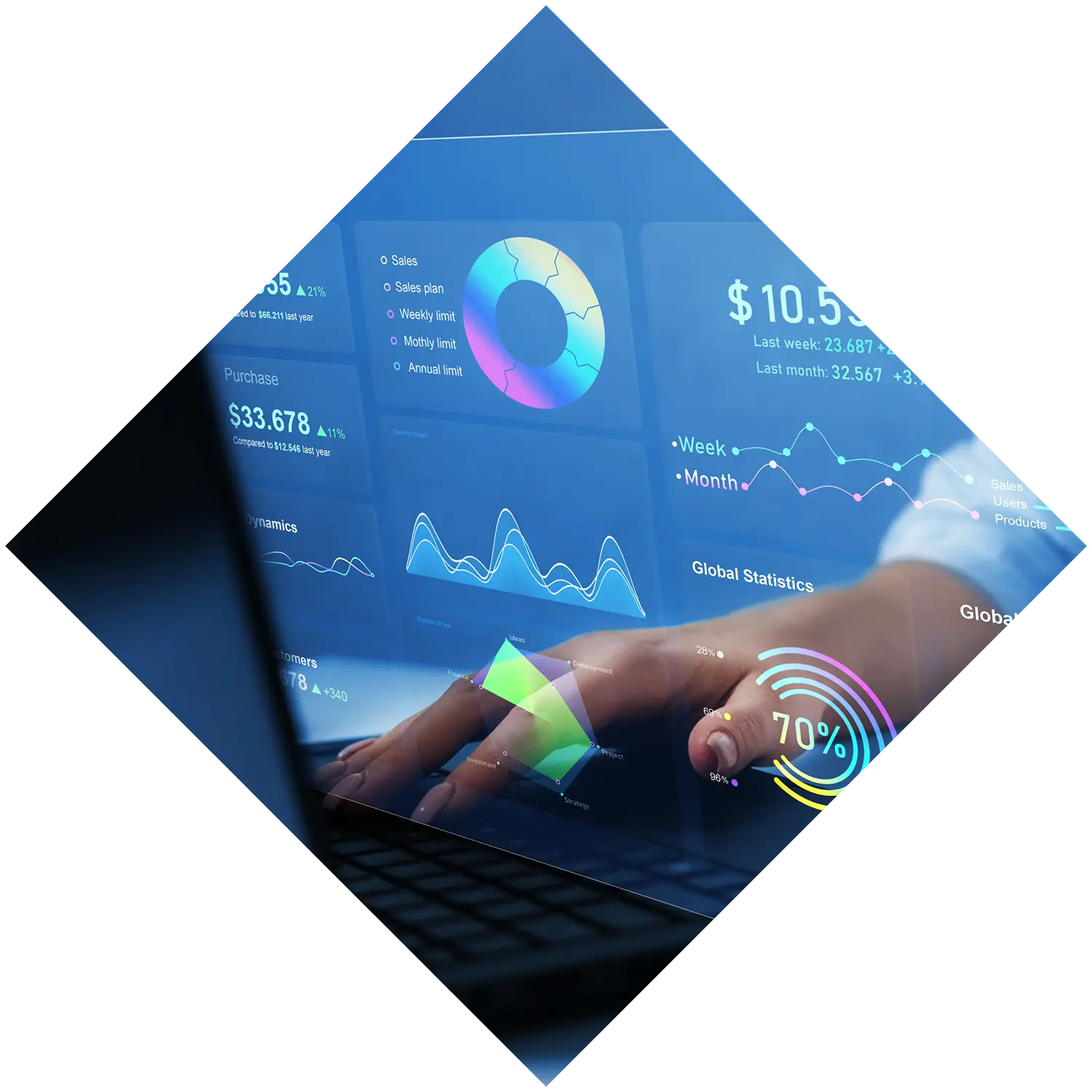Artificial Intelligence (AI) is changing the way businesses work across the board. One of the best examples of an impressive paradigm shift is the launch of ChatGPT, which sparked a significant surge of interest in generative AI due to its accessibility and results for users at every level of business. There is also a growing fascination with machine learning (ML), data science, and other vital applications of AI to identify ways to improve business operations. What was once a relatively small field obtainable only to enterprises or scientific fields is now open to all businesses willing to adopt a new way of operating to gain a competitive edge.
A recent survey by McKinsey found that a vast majority of people have had some exposure to AI: "Seventy-nine percent of all respondents say they've had at least some exposure to gen AI, either for work or outside of work, and 22 percent say they are regularly using it in their own work. While reported use is quite similar across seniority levels, it is highest among respondents working in the technology sector and those in North America."
If you want to make AI work for your business, you first need to figure out if AI is the right solution for your challenges, how AI can help achieve your specific goals, and how to incorporate it into your existing processes.
Businesses increasingly utilize artificial intelligence and machine learning to revolutionize their operations. The drive toward digital transformation has underscored the critical role of these technologies in enhancing productivity, optimizing processes, and creating value in unprecedented ways. As the landscape of AI and ML becomes more accessible to all businesses, it is evident that its impact transcends mere operational efficiency, opening new avenues for innovation, customer engagement, and strategic decision-making.
The adoption of AI and ML is reshaping the business environment, offering tools and methodologies that address complex challenges, streamline workflows, and uncover insights hidden within vast pools of data. These technologies are at the forefront of the modern digital revolution, empowering businesses to surpass traditional limitations and redefine their potential. From workflow optimization ensuring seamless operations to predictive analytics anticipating future trends, AI and ML are pivotal in driving businesses toward their goals with precision and agility.
Workflow Optimization for Enhanced Productivity with AI/ML
Workflow Optimization for Enhanced Productivity with AI/ML
Integrating artificial intelligence and machine learning into your workflow optimization strategies can be a game-changer. AI and automation technologies can streamline your business processes, leading to quicker project completion, cost savings, and more productive teams. While businesses can use AI/ML on nearly any problem, some focus areas yield better results from this technology, whereas traditional methods or standard computing may be a better choice in another area. Below, we cover the most common uses why a business might implement AI/ML to tackle complex problems.
Identifying and Resolving Bottlenecks with Process Mining
When the data is available, AI models can meticulously analyze your workflows to pinpoint bottlenecks and areas of inefficiency. By scrutinizing the flow of tasks and processes, AI can isolate the specific steps or stages causing delays or resource wastage. Businesses can proactively resolve them, ensuring smoother and more efficient operations.
Predictive Analytics for Resource Allocation
AI's predictive analytics capabilities allow for better resource allocation. For example, AI can predict when equipment will likely require maintenance in manufacturing, reducing unplanned downtime. AI can forecast resource requirements and timelines more accurately in project management, aiding resource allocation and scheduling decisions.
Process Automation
Automation is a critical component of workflow optimization. AI-driven automation tools can handle routine and repetitive tasks like data entry, generating reports, and other data-focused work. As a result, this mitigates human error and allows employees to focus on higher-level creative or strategic tasks. Automating repetitive processes in manufacturing or administrative tasks leads to significant time and cost savings.
Adaptive Learning and Continuous Improvement
ML models can continuously learn from the data generated by your workflow processes. Over time, these models can adapt and recommend process improvements, leading to ongoing optimization. It is particularly valuable in complex industries where workflows are subject to change and evolution.
Enhanced Collaboration and Communication
AI tools can improve collaboration by providing better communication platforms, suggesting meeting times, or summarizing discussions for reference. These features promote effective teamwork and faster decision-making.
Transforming Business Landscapes: AI and ML Application Uses
Artificial Intelligence and Machine Learning are pivotal in reshaping business operations, offering novel solutions across departmental use cases. The following use cases highlight how AI and ML optimize processes, enhance decision-making, and create competitive advantages, from predictive maintenance and sales optimization to customer service improvements and research innovations. We're covering some of the most popular use cases accessible to businesses today.

Data Analytics and Business Intelligence
Data Analytics and Business Intelligence
1. Data Cleaning & Validation Platform
It's essential to clean and validate your data to ensure data quality. This process helps avoid the "garbage in, garbage out" problem. Automated data validation, including checks against external data sources, can be scheduled and substantially improve data quality.
2. Data Integration
Combining data from various sources and structuring it into a meaningful format is paramount. Given the diverse platforms that generate data, effectively managing data traffic and maintaining a well-structured data lake becomes essential to fully harnessing your data's potential for analysis.
3. Data Management & Monitoring
High-quality data is essential for advanced analytics. Automating tasks like data filtering and maintenance can save time and ensure data integrity, setting the stage for more effective analysis.
4. Data Preparation Platform
Preparing raw, potentially messy data for analysis is a crucial step. Using extract, transform, and load (ETL) platforms can refine data, making it clean and ready for analysis before placing it in a data warehouse.
5. Data Transformation
Sometimes, data may be unstructured or in a format unsuitable for analysis. Data transformation processes adapt data to meet advanced analytics requirements, ensuring it's in a suitable format for drawing insights.
6. Data Visualization
Visualizing data is essential for comprehending complex information and making data-driven decisions. Dashboards and data visualization tools present data aesthetically, making it easier for stakeholders to understand and act upon insights.
7. Data Labeling
Highly labeled data is necessary to train models effectively in supervised learning systems. Human-in-the-loop systems can automate the labeling process and crowdsource labeling for data points that cannot be auto-labeled confidently or where a human should still monitor the final decision.
8. Synthetic Data
Sales and Marketing Optimization
Sales and Marketing Optimization
AI and machine learning solutions are at the forefront of sales and marketing optimization, offering a treasure trove of benefits from their predictive capabilities, automation, and insights.
9. Sales Trends Prediction
AI and ML can predict future sales trends with remarkable accuracy by utilizing historical data and external factors; these technologies enable businesses to allocate resources effectively. Thus, this ensures inventory levels are optimized, and marketing campaigns are well-timed and strategically planned. The ability to anticipate future demand empowers companies to reduce costs and improve revenue by aligning their sales strategies with market dynamics.
10. Automating Sales Processes
Routine tasks within the sales process, such as data entry and follow-ups, can be automated with AI. AI-powered chatbots, for example, can engage with leads, answer common inquiries, and even schedule appointments. This automation liberates sales representatives from mundane tasks, allowing them to focus on connecting with prospects and responding more immediately to customer and market needs - the result - is increased productivity and shorter sales cycles.
11. Marketing Optimization
AI is a marketing maven when analyzing data from various channels and campaigns. Machine learning algorithms assess the performance of different marketing channels, content types, and messaging to identify what works best. With this data-driven insight, marketers can allocate their resources to the most effective strategies. The outcome is a higher return on investment (ROI) and more efficient budget allocation.
12. Personalized Marketing
AI can help tailor marketing efforts to individual customer preferences. AI can craft personalized recommendations and content by analyzing customer behavior and demographics, improving engagement, and driving sales.
13. Customer Journey Mapping
AI and ML solutions are adept at mapping out the customer journey. Businesses gain insights into customer lifecycle by analyzing touchpoints and interactions across various channels. Therefore, this enables the development of targeted strategies for different customer journey stages, enhancing customer satisfaction and loyalty.
14. Dynamic Pricing
Dynamic pricing is an area where AI excels. Algorithms can analyze market conditions, competitor pricing, and customer behavior in real-time to adjust prices for maximum profitability. This strategy not only increases revenue but also maintains competitiveness.
15. A/B Testing and Optimization
AI can continuously conduct A/B testing to optimize marketing campaigns. It can quickly identify which variables lead to the best results, helping marketers make data-driven decisions and refine their strategies in real-time. These technologies are invaluable assets for keeping up with the competition and maximizing revenue potential by predicting trends, automating tasks, optimizing strategies, and personalizing interactions.
16. Customer Segmentation and Personalization
Understanding your customers is crucial for targeted marketing and improved customer experiences. AI-driven customer segmentation and personalization solutions can analyze vast datasets to identify customer preferences and behaviors. By tailoring marketing messages and product recommendations, you can enhance customer engagement, boost conversion rates, and increase customer loyalty.
Natural Language Processing (NLP) & Generative AI (GenAI) Solutions
Natural Language Processing (NLP) & Generative AI (GenAI) Solutions
Natural language processing and generative AI are versatile and powerful fields within artificial intelligence that revolve around how computers understand and reproduce human language in contextual settings. NLP and GenAI can significantly impact various facets of business operations and productivity, including sentiment analysis and brand reputation management.
17. Content Creation
GenAI algorithms excel at generating human-like text. They can streamline content creation processes by automatically producing product descriptions, reports, news articles, and marketing materials. Consequently, this saves time and ensures consistent and engaging content.
18. Translation and Localization with NLP Programs
NLP is instrumental in translating and localizing content for global markets. It can automatically translate and adapt text to cultural nuances, ensuring your message resonates with international audiences. Correctly translated content is essential if you're looking to expand to diverse markets. Remember to do a localized plagiarism checker because material not plagiarised in one language may inadvertently match content in another.
19. Customer Support with NLP & GenAI
NLP can enhance customer support by understanding incoming requests and GenAI by automating responses to common customer inquiries. Chatbots and virtual assistants, equipped with NLP/GenAI capabilities, can provide instant support by understanding and responding to real-time customer queries. It improves customer satisfaction and frees up human resources for more complex issues.
20. Data Extraction and Summarization
NLP tools can quickly extract and summarize information from vast datasets, research papers, and documents. Hence, this is invaluable for research-intensive industries, such as academia, finance, and healthcare, where analyzing extensive textual information is essential for decision-making.
21. Market Research and Competitive Analysis
NLP-driven market research tools can delve deep into unstructured data like news articles, social media, or research papers to uncover valuable insights about your industry and competitors. By analyzing vast amounts of text data, NLP can provide market trends, customer preferences, and competitive intelligence, allowing businesses to stay ahead of the curve with data-driven decision-making.
22. Personalization and Recommendations
NLP is at the core of personalized recommendations at scale wherever text data is available. By analyzing user behavior and preferences through text data, NLP can suggest products, content, or services highly relevant to similar users, increasing engagement and sales.
23. Compliance and Risk Management
NLP can help businesses navigate the complex landscape of regulations and compliance. It can analyze legal documents and contracts to ensure companies adhere to legal requirements, reducing non-compliance and associated legal issues.
24. Voice Assistants and Voice Recognition
AI-Powered Customer Service Solutions
AI-Powered Customer Service Solutions
Customer service plays a crucial role in shaping brand reputation and customer loyalty. While AI-powered chatbots are a significant part of modern customer service solutions, a wide range of AI-driven tools and technologies can enhance and streamline customer interactions.
25. Chatbots and Virtual Assistants
26. Email Management
AI tools are proficient at automatically categorizing and prioritizing incoming emails. They can intelligently route emails to the correct department or team and draft responses based on predefined templates. By automating email management, businesses can significantly speed up response times and efficiently address customer inquiries.
27. Social Media Management
Social media is a critical customer service channel in the digital age. AI-driven tools can monitor brand mentions, comments, and messages across various social platforms. They automatically respond to common inquiries and detect and escalate urgent issues to human operators when necessary. Additionally, these tools can analyze social sentiment to gauge public opinion about your brand, allowing for real-time adjustments in response strategies.
28. Knowledge Management Systems
AI can help businesses create and maintain comprehensive knowledge bases. These systems can automatically organize and categorize information, making it easier for customers and support agents to find answers to common questions. When fine-tuning is available, AI-driven knowledge management systems evolve, becoming increasingly efficient and accurate as they learn from customer interactions.
29. Predictive Analytics and Customer Insights
AI can analyze extensive customer data sets to predict trends, preferences, and potential issues. By leveraging predictive analytics, businesses can proactively address customer needs, offer tailored solutions, and optimize their service offerings to align with customer expectations.
30. Self-Service Portals and FAQs
AI-Powered Research and Development
AI-Powered Research and Development
AI-powered research and development (R&D) transforms how industries approach innovation and experimentation. Here's an expanded look at the profound impact of AI in this domain:
31. Accelerated Experimentation
AI models possess the unique ability to simulate a diverse range of experiments and complex scenarios. This capability drastically expedites the R&D process, allowing researchers to explore multiple hypotheses and conduct virtual experiments in a fraction of the time required by traditional methods. This acceleration is significant in pharmaceutical industries, where discovering and testing new drugs can be time-consuming and financially burdensome. AI enables rapid iteration and testing, significantly reducing the time-to-market for new medications.
32. Pattern Identification and Data Analysis
AI shines in the realm of data analysis and pattern identification. It can process and make sense of enormous datasets in ways that might elude human researchers. In areas such as materials science, AI's analytical prowess is invaluable. It can analyze the properties of various substances to identify new materials with unique characteristics. By recognizing patterns and correlations in data, AI assists researchers in developing novel materials with enhanced properties, revolutionizing product development.
33. Optimizing Resource Allocation
AI-driven predictive models help optimize resource allocation in R&D projects. AI can recommend where to allocate time, money, and expertise by assessing the potential outcomes of various research avenues. Thus, this is particularly valuable in industries with limited R&D budgets, as it ensures that resources go towards the most promising projects.
Image and Video Services
Image and Video Services
Extracting valuable insights from this vast media content pool is a Herculean task for humans alone. AI-driven image and video analysis solutions are revolutionizing how we interact with and utilize visual data, offering many possibilities. Here's an in-depth look at the multifaceted role of AI in this field:
34. Advanced Pattern Recognition
AI image and video analysis solutions can decipher intricate patterns, identify objects, and recognize faces within visual data. Whether sifting through security footage to detect anomalies or cataloging vast image libraries, AI's pattern recognition capabilities are invaluable. These solutions process immense volumes of multimedia content with extraordinary speed and accuracy, surpassing human capabilities. This enhanced data interpretation is a game-changer in sectors like security, retail, and healthcare, where timely and precise insights are crucial.
35. Content Generation
AI solutions extend their capabilities to create images and videos. For instance, Generative Adversarial Networks (GANs), a subset of AI, are masterful at crafting highly realistic images that often blur the line between actual and generated content. GANs are built from a generator and a discriminator, which use a competitive process to produce and evaluate images. The applications of GANs span art creation, design elements, and even the development of photorealistic faces, catering to creative and industrial needs alike.
36. Converting Text to Images or Video
AI models have the incredible ability to translate textual descriptions into corresponding images. For instance, you can describe a scene, and the AI will generate an image or video that accurately mirrors that description. This capability finds applications in various domains, from content creation to architectural planning, by bringing concepts and ideas to visual life. Text-to-image is undoubtedly further along in output accuracy, including a sense of object permanency, but text-to-video is rapidly developing to become a usable part of video processes.
37. Facial Recognition and Security
In security, AI image analysis is pivotal in facial recognition systems. These systems enhance security protocols, streamline access control, and facilitate surveillance operations. They have applications in identity verification, border control, and law enforcement.
Comprehensive Risk Management
Comprehensive Risk Management
Comprehensive risk management is a linchpin of strategic decision-making, ensuring the long-term success of businesses. AI's predictive capabilities transform how organizations approach risk assessment, enabling them to forecast potential threats and opportunities. This predictive prowess isn't just about offering a glimpse into the future; it empowers businesses to be proactive and strategic in their approach to risk mitigation through predictive models and customized risk indicators.
38. Predictive Models
AI is adept at creating predictive models that can anticipate various risks. These risks encompass market fluctuations, supply chain disruptions, regulatory changes, or a myriad of factors that could impact a business. Organizations gain the advantage of implementing preventive measures and mitigation strategies by identifying potential risks before they materialize. This proactive stance allows them to navigate uncertainty more effectively and minimize the impact of adverse events.

39. Customized Risk Indicators
Virtual Personal Assistant Services
Virtual Personal Assistant Services
While AI plays a pivotal role in enhancing these services, it's essential to understand that automation can effectively handle numerous routine tasks before AI's advanced capabilities come into play. The synergy between automation and AI is crucial to achieving the most efficient outcomes.
40. Automation for Routine Tasks
Automation excels at managing repetitive and routine tasks, constituting a significant portion of daily responsibilities. These tasks may include appointment scheduling, data entry, email filtering, and fundamental data analysis. Automation ensures the quick and accurate execution of these processes, saving time and minimizing human error.
41. AI for Intelligent Decision-Making
AI's true strength comes when tasks demand higher intelligence, decision-making, or natural language understanding. For instance, AI-powered chatbots are proficient in handling customer inquiries, resolving complex issues, and engaging in natural language conversations. They adapt to customer queries and learn from interactions, providing personalized assistance and problem-solving abilities.
42. Seamless Integration and Cross-Platform Efficiency
The beauty of combining automation and AI is the seamless integration of these supportive capabilities. Automation takes care of routine, rule-based tasks, while AI steps in when tasks require cognitive thinking and adaptability. Together, they create a comprehensive and versatile virtual assistant capable of efficiently managing various tasks.

Resume Screening and Candidate Matching
Resume Screening and Candidate Matching
AI has become an invaluable asset in the recruitment process, particularly in resume screening and hiring. It offers various advantages, such as accelerating the initial candidate evaluation and ensuring a more objective assessment of qualifications. However, it's crucial to recognize the potential for bias and the importance of careful AI implementation to comply with legal standards. Additionally, as these systems become more prominent, we've seen a rise in valid candidates not getting callbacks for jobs they are well-qualified for. Ultimately, your team needs to spot-check, validate results, and support fine-tuning AI models that filter between a good candidate for that role and one that doesn't match.
43. Efficient Resume Analysis
AI algorithms are remarkably efficient at scanning and processing numerous resumes rapidly. They extract vital details, including qualifications, work experience, skills, and education, significantly reducing the time recruiters spend on this initial screening. This efficiency is a game-changer in talent acquisition, freeing recruiters to focus on more strategic aspects of the hiring process.
44. Objective Screening
AI-driven resume screening minimizes human biases that may inadvertently influence candidate selection. AI ensures a more objective assessment by evaluating resumes based on predefined criteria, keywords, and job requirements. This objectivity is crucial for creating a level playing field for applicants, regardless of their background or personal characteristics.
45. Best-Fit Matching
Supply Chain Optimization and Inventory Management
Supply Chain Optimization and Inventory Management
Effective supply chain management and inventory control are essential for the seamless operation of businesses. AI has emerged as a key player in optimizing these critical aspects, and here are a few business cases to consider:
46. Demand Forecasting
AI-driven algorithms can analyze historical sales and market trends to generate detailed demand forecasts. These forecasts provide invaluable insights for inventory planning and production scheduling. By predicting demand precisely, businesses can reduce excess inventory and minimize stockouts, leading to significant cost savings and, more importantly, heightened customer satisfaction.
47. Dynamic Inventory Management
AI-powered inventory management systems can continuously analyze many factors, including demand patterns, lead times, and seasonality. By considering these variables, AI helps determine the optimal stock levels. Thus, this ensures that businesses neither overstock nor understock products, optimizing working capital. Inventory management is a crucial facet of supply chain optimization, as it directly affects carrying costs, storage, and the efficient use of resources.
48. Supplier Performance and Risk Assessment
AI can assess supplier performance by analyzing data related to on-time deliveries, product quality, and pricing trends. It also identifies potential risks within the supply chain, such as geopolitical instability or natural disasters. With early warning systems, businesses can proactively mitigate risks and ensure a smoother, more resilient supply chain.
49. Route Optimization
AI algorithms can optimize the routing of transportation, making it more efficient. By considering factors like traffic conditions and weather, AI ensures that goods are transported with minimal delays and at the lowest cost, reducing lead times and transportation expenses.








